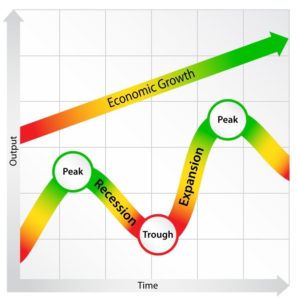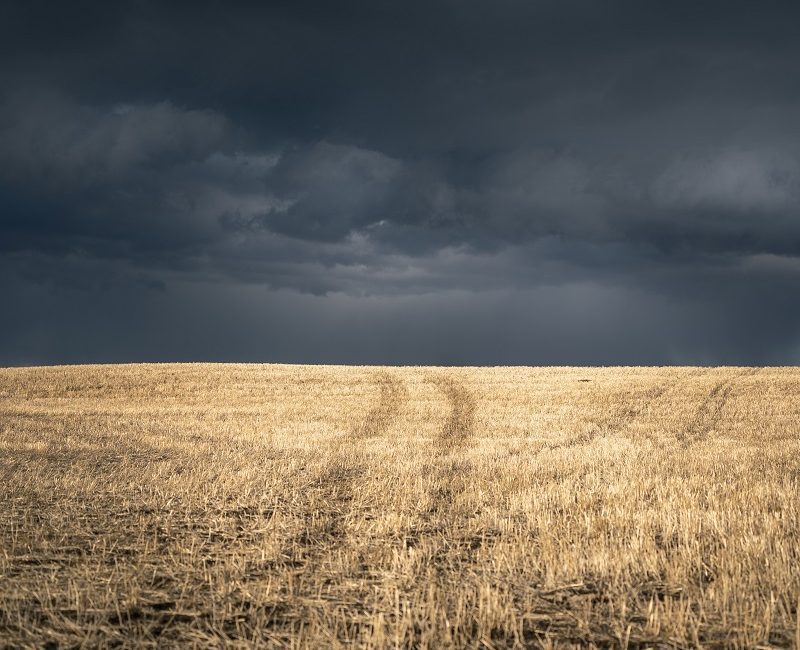Interest rates are rising, inflation is at its highest in 40 years, and the market is going into a deep slow down. And that means all signs point to recession.
Anyone reading this has lived through at least one major recession, and in fact, the economy seldom plateaus. But what exactly is a recession? What causes them? What are signs that one is on its way?
Before we answer those questions, we need to understand the four different stages in the cyclical pattern of the economy — expansion, peak, contraction, and trough.
Four Economic Stages
The interesting thing about any of these four stages is that you don’t really know for sure which you’re in, especially peaks and troughs, until after the fact. When the numbers come out that reveal the state of the economy during a specific time, you may have already moved into the next phase of the cycle.
Fortunately, there are signs you can read to help you make an educated guess in real-time.

Expansion (growth)
During the expansion phase of the cycle, the economy grows. Interest rates are usually low, production is high, along with inflation. Things might feel too good to be true for a while, because they are. A peak is coming, and once you peak, there’s only one way to go.
Indicators:
- Employment is high
- Supply and Demand of goods is up
- Income and wages grow
- Bills/debts paid on time
- More disposable income
- More investments in bonds, gold, real estate, and especially equities (stocks)
Peak
During a peak, economic growth has maxed out. Like a rollercoaster car summiting the peak of the first big hill, things will soon start to drop — growth, inflation, production. Essentially, the economy begins to correct some of the imbalances created by rapid expansion. The peak of a cycle is reached when growth hits its maximum rate.
Indicators:
- Economic activity of expansion is saturated
- Economic growth slows
- Prices peak
- Unemployment rate is between 2-5%
- Demand for goods is so high that more people are employed to meet demand
- By the end of the peak, you’ll start to see reversals of growth indicators
Contraction (recession)
The economy begins to correct itself after the ballooning of the expansion period. Growth slows, prices stagnate, and employment falls. One of the first casualties of recession are, unfortunately, jobs. This is a time when a lot of companies begin to tighten their belts, and that can mean layoffs.
A prolonged recession stage is known as a depression. A depression is indicated by a GDP drop of 10% or more and three or more years of recession.
Indicators:
- Demand for products and services plummets
- Excess supply of goods because businesses still produce at expansion levels
- Over-supply causes prices to drop
- Increase layoffs
- Unemployment rate rises
- Wages go down
- Less disposable income
Trough
When a recession has reached rock-bottom and then begins its upswing, signaling that it’s entered a new phase of recovery/expansion. We can call this the darkness before the dawn.
Indicators:
- Economic growth rate reaches its lowest level
- Both supply and demand of goods and services are at their lowest
- Unemployment is high
What is a recession?
Let’s go into a little more detail on recessions.
Recessions refer to the state of the economy at a macro level, meaning you will see its effects across all areas of the economy. During a recession, there is a significant slowdown in economic activity.
Of course, the economy isn’t static. It fluctuates constantly. But for a period of widespread economic slowdown to be defined as a recession, that economic contraction has to last for more than a few months, or two quarters by some definitions. Though the economy isn’t “officially” in recession until the National Bureau of Economic Research declares it, you can certainly read the signs if you’re looking.
As mentioned above, recession is just one of the phases in the economic cycle. As the economy contracts, you’ll notice a lot of things contract along with it. Businesses and banks are more apt to fail. Production wanes. Stocks drop. The GDP shrinks. The only thing that seems to grow is the unemployment rate and national debt.
Recessions are a turbulent time for many industries, often exacerbated by government policy changes that are made in response to the economic climate. And they can be especially devastating times for the most vulnerable, whose incomes are the first to be consumed by the rising tide of inflation at the beginning of a recession, and whose positions are often the first to be eliminated in inevitable layoffs. Recessions can be a distressing time, socially, politically, and personally.
But as Sean stresses, there are opportunities in every economic environment, which is why one of NEST core strategies is to constantly monitor the global economy at a macro level. This allows us to adjust our portfolios into more secure and even profitable investments.
Reasons recessions happen
Sudden economic shock – For example: global pandemics like Covid, military conflicts, OPEC cutting off oil to the US in the 70s.
Excessive debt – Both from individuals and businesses. Defaults and bankruptcies are muy malo for the economy. For example: the housing crisis of 2008.
Asset bubbles – Too much optimism on the part of investors can inflate the stock market or create real estate bubbles. But every bubble pops…
Spiking inflation – Sounds pretty familiar right now. Inflation is generally always going on, and it isn’t necessarily bad. But when prices rise too quickly it is. The central banks try to slow the rate of inflation by raising interest rates to stop people from buying. Lowering demand will lower costs, and slow inflation. But it can also send the economy into recession.
Rapid deflation – The other side of the inflation coin. Dropping prices cause wages to contract, which causes prices to fall, etc. It’s a vicious cycle. When people and businesses stop spending, it’s bad for the economy.
Technological progress – New inventions can be a good thing, but when they make entire sectors obsolete, it can be crippling for the economies as the workforce adjusts to these major shifts.
Are we in a recession now?
It’s actually impossible to know whether we’re in a recession in real time. We have to wait until the numbers for two quarters have come out and the NBER declares it. But as of publication, the economic climate displays many of the signs indicating we’re at a peak — Inflation is out of control, the Fed is raising interest rates, personal debt is growing, etc.
While no one can predict the future, you don’t need to be a psychic to know that if there are storm clouds overhead, you’re likely to get rain.
So, what should you do to prepare for a recession, should one be impending? Check out our next post for things you can do to ensure your finances and investments are positioned to weather a recession.
If you have more questions about the economic cycle and recession, or if you’d like to see if your investments and finances are positioned to help you thrive, whatever the economic stage, why not schedule a no-obligation call with us? Education is at the heart of what we do at NEST, and our passion is to help people make good decisions with their finances. We serve the Austin and Hill Country area, and we’re ready to offer our nearly 30 years of experience to help you reach your goals.
Find us on:
LinkedIn Facebook Yelp Twitter
DISCLAIMER: We are legally obligated to remind you that the information and opinions shared in this article are for educational purposes only and are not financial planning or investment advice. For guidance about your unique goals, drop us a line at info@nestfinancial.net.






[…] we’ve mentioned in previous posts, the economy is constantly expanding, peaking, contracting, or in a trough. And while it’s impossible to know exactly where we are in the economic cycle until the moment […]
[…] Thus begins an economic downturn. This is a natural part of the economic cycle. […]
[…] economy is always in a state of flux as it moves through the different stages of the business cycle. If that happens, make sure that you’re able to adapt to ensure that your business avoids […]
[…] Just a quick refresher for those who missed our last post. For a more in depth look at the economic cycle and recessions, we highly recommend you check it out. […]